Sadeghi Limanjoob Reza1*, Farzam Mohsen2 ,Jamali Houshang3, Syahmard Nahid4, Kargar Jahromi Hossein5 and Farzam Mohammad 2
1Department of Aquatic Animal Health, Veterinary School, Kazerun Branch, Islamic Azad University, Kazerun, Iran.
2Department of Physiology, Veterinary School, Kazerun Branch, Islamic Azad University, Kazerun, Iran.
3Department of Microbiology, Jahrom Branch, Islamic Azad University, Jahrom, Iran.
4Department of Physiology, Medical School, Kazerun Branch, Islamic Azad University, Kazerun, Iran.
5Zoonoses research center, Jahrom University of Medical Sciences, Jahrom, Iran.
DOI : https://dx.doi.org/10.13005/bpj/495
Abstract
This study was designed to investigate the rate of common carp (Cyprinus Carpio) to Lernaea cyprinacea. 275 pieces weighing more than 150 grams were caught from 4 fish farms in the Shushtar city located in the four cardinal directions, in September and October of 1388. The collected samples were placed in 20 liter drums containing 10% formalin and then were transferred to the laboratory of Veterinary School in University of Kazerun. The Samples were studied in terms of total length, standard length, body height and weight. In the next stage, the infected fish were separate from other fish and infected were evaluated regarding Lernaea Cyprinacea infection. : The results showed that 69 % of the total numbers of fish caught were diagnosed with Lernaea Cyprinacea. Frequency of fish’s infection to the parasites was reported as 09/25%. Also, investigation of the relationship between total length and weight with infection rate to Lernaea Cyprinacea showed a significant relationship between the variables (parameters) above with the rate of infection to the parasite.This study determined the prevalence of carp fish infection to Lernaea Cyprinacea as 09/25%. This study also indicated that a significant relationship between the total length, standard length and weight with the rate of infection.
Keywords
Cyprinus Carpio; Lernaea Cyprinacea parasite; farming pond; Khuzestan
Download this article as:| Copy the following to cite this article: Reza S. L, Mohsen F, Houshang J, Nahid S, Hossein K. J, Mohammad F. Infection Rate of Common Carp (Cyprinus Carpio) to Lernaea Cyprinacea Parasite in Warm Season of Year in Farming Ponds of Shushtar Region in Khuzestan Province. Biomed Pharmacol J 2014;7(1) |
| Copy the following to cite this URL: Reza S. L, Mohsen F, Houshang J, Nahid S, Hossein K. J, Mohammad F. The Study of Investigating Catching Rate of Esterpotokosis Disease on Breeding Farms of Rainbow Trout (Onchorhynchus mykiss) Arjan Sector of Shiraz City. Biomed Pharmacol J 2014;7(1). Available from: http://biomedpharmajournal.org/?p=2982 |
Introduction
Early human provided their food needs through hunting and gathering food around them, but population growth of the world and subsequently Iran increased need to variety of plant and animal proteins. In recent decades people have come to the conclusion that by farming Aquatic animals can provide production beyond existing products (1). Common carp with scientific name of “Cyprinus carpio”, was originally native to Central Asia and over many centuries has spread naturaly to different regions of the world or has transferred by human. To identify this fish, observing two pairs of mustache around the mouth and continuous dorsal fin will suffice. Its dorsal fin is long and reaches near the caudal peduncle. Two pairs of mustache around the the lips and its pharyngeal teeth are three rows (no teeth on the jwas). It is an Omnivore fish and eats benthic organisms (worms, molluscs, crustaceans, etc), baby frogs, baby fish, fish eggs, seeds, plants leaves and the like. It has High growth rate and is relatively resistant to adverse conditions and environmental conditions. It also weighs up to 15 kg. In our country, in some areas such as Khuzestan, in the first year of farming, the fish weighed gets more than 5/1 kg (2).
Given the importance of fish farming industry in recent years, particularly warm water fishes including carp in Iran, Investigating illnesses and injuries in these species is essential. Of course the aquaculture industry is faced with many threats such as different diseases including viral, bacterial, parasitic, etc.
Lernaea Cyprinacea and occurrence of Lernaeasis in farmed warm water fishes is a major problem of this industry all over Iran. The province of Khuzestan is the most important one regarding Lernaeasis that encounter with the illness almost all year. The reason for this is suitable temperature range in most months of the year for rapid growth and proliferation of the parasites especially from early spring to late fall when water temperatures is typically between 30-22 º C in pools. Proliferative capacity of the parasite is high so that in 22-17 days of the complete life cycle, the parasite is repeated (3). Parasites are considered causes of small damages to large ones in both marine and farmed fishes and lead to pathological changes, reducing the quality and lessening marketability of fish. The recent spread of parasites throughout the world is performed easily due to lack of adequate health and veterinary supervision in process of fish importing. Controlling many important parasitic diseases is still far from satisfactory condition and more supervision is needed. Aquaculture development over recent decades, and concern about the prevalence of parasites has caused experts’ more attention to this problem created by parasites and their importance in decreasing Aquatic animals’ reproduction power (4). In general, common crustacean parasites of fresh water fishes of Iran belong to two classes of spp. Acartia and branchiura.
In the range of spp. Acartia the following fishes are discussed: lernea, Ergasilus, Lamproglena, Traclea stes, pseudo Traclea stes, actress, and caligus. And in the range branchiura, argulus is discussed. Lernea is one the most well-known parasitic crustaceans that reproduces continuously in warm seasons as subcutaneous parasites, and its adult type sets on the skin of every four warm water fish species farmed in Iran (grass carp, Bighead, silver and common) that can create skin damage effects, reduced growth and effect on fish behavior and decrease fish resistance against stress factors .also, presence of parasites can cause negative effects on the marketability of fish. Different species of Lernea are among the most dangerous parasites of farmed freshwater fish in the world and Iran; and with the development of focused fish farming; their importance is felt more sensiblely. They are specila of tropical temperate regions. So far, 40 species of Lernea have been recognized in the world, 32 species of which are named and some have synonyms. L.ctenopharyngodoni, L.esocina, L.cyprinicea, L.elegans, L.carassi are species of the Larena genus (5). In fish farming fields of Iran, because most of them use resources of surface waters such as rivers, At about 6-10 months of the year the average temperature of swimming pools gets above 14-15 ° C, there is the possibility of disease occurrence. On the other hand, the tadpole is one the disease transmission factor (5). Parasite has a wide host domain and large number of fish family particularly Carp species can be prey of parasites. Also, the parasite does not require an intermediate host for growth and development (3).
Methods
sampling was done from fish farms in Shushtar city. These fields are near Gargar branch of the Karoon river . Samples were taken from four farms in the four cardinal directions of pools towards each other; that is from northernnmost to the southernmost, easternmost and westernmost and from major fields.
Selected fields included
Nourali Chehelparzin farm with management of Afshari Brothers that is 55 hectares.
Fish farming field with management of Afshari and Pourafshary that is 52 hectares.
Fish farming field with management Akhavan Nassaj that is 45 hectares.
Fish farming field with management of Seyed Mahdithat is 48 hectares.
One sampling was done on the date 6/23/88 from field, 1 and 2 the total number o samples was 150 (78 samples from field 1, and73 samples from field 2).
Another sampling was done from field 3 on the date 6/31/88 and the number of samples was 55. Sampling from field 4 was done on the Date 07/24/88 and number of samples was 70. The total number samples en tak from four farms was of 275. From each field, 4 polls that its fish weighed up to 150 grams were selected randomly and using a hand net (vetch)[1] fishes were caught. It was tried to have equal number of launching net in each pond and also worker fisherman was asked to do hand net throwing from four different locations in the pool to perform sampling from different points in pool. Finally 80-60 fish samples were collected from each farm. To stabilize the Samples taken, they were put in 20 liter drums that were contained 10% formalin and the door was shut well and drums were transferred to laboratory of veterinary school in KAZERUN. In vitro studies were conducted on fixed fish in 10% formalin, and in each time two drums were spilled in plastic tubs. At first the fishs’ skin were removed from formalin and then healthy fish were sepatared from fishes with parasites were and each category were counted separately. Finally the Data was put in tables and some of lesions caused by parasitic were cut from the body surface of fish by scalpel blade and forceps with graving method. Samples were put under the microscope and at the end the sample under the microscope were photographed. The data obtained were analyzed by spss software and the results are presented in the results section.
Results
Result of examining infections of common carp (Cyprinus carpio) in a warm season is as follows: From total number of 275fishes caught, 206 were healthy and the rest of the 69 pieces were all suffering from parasitic lesions. Digram (1) shows the number of healthy and infected samples of common carp under stdudy of Larean infection in the region of Khuzestan.
[1] Hand net (vetch) is a kind of device for catching fish that is made of Chaperone string as funnel such that at the top of pyramid there is a rope, which is usually cotton And the lower part of funnel that while fishing makes a circle with diameter from 2 to severla meters is connected regularly. The thinness of Chaperone string and size of springs that are currently common in Iran are 10 mm – 20 mm and 40 mm. The device is used in shallow areas such as ponds of fish farming workshops. And mostly used in sampling fish from fish farming ponds (4).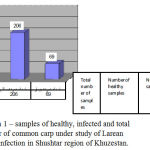 |
Figure 1: samples of healthy, infected and total number of common carp under study of Larean parasitic infection in Shushtar region of Khuzestan.
|
Estimating percentage of common carp infected To Lernaea Cyprinacea
In the next step, percentage of healthy samples and infected with parasites were dertermined so that we know what proportion of statistic population form. This number shows what percent of statistic population are infected with parasite. This number can be very effective in decisions and research in this area. (Diagram 2).
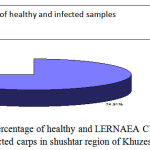 |
Figure 2: percentage of healthy and Lernaea Cyprinacea infected carps in shushtar region of Khuzestan
|
The Scatter Plot That Examines The Relationship Between Total Length And Number Of Lesions Of Lernaea Cyprinacea Shows A Significant Relationship Between These Two Variables.
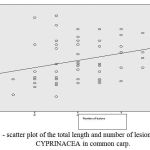 |
Figure 3: scatter plot of the total length and number of lesions of Lernaea Cyprinacea in common carp.
|
This diagram, like the previous diagram shows significant relationship between these two variables. As the numbers and relations show, the relationship between number of parasitic lesions in fish with length or weight is significant. (P <0.05).
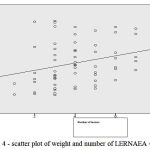 |
Figure 4: scatter plot of weight and number of Lernaea Cyprinacea Lesions in common carp.
|
This diagram like the previous one shows significant relationship between the two variables. As the numbers show the relation between numbers of parasitic lesions with standard length is significant. (P <0.05).
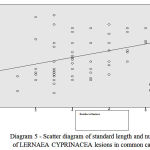 |
Figure 5: scatter diagram of standard length and number of lernaea cyprinacea lesions in common carp.
|
Discussion
in this study, 275 common carp fishes from fish farming ponds in the city of shushtar in khuzestan province were investigated regarding infection to lernaea cyprinacea; that 69 of them were infected with lernaea cyprinacea and contamination rate was 09/25% which is consistent other studies in the area of shushtar. but the differences of contamination in this area with other areas in the world can be attributed different climatic conditions, sensitivity, and other conditions in the incidence rate of the epidemic parasite. the survey conducted by the kularatne et al (2002) reported species sensitivity of resistant carps against lernaea cyprinacea than lernea minuta parasites (6). in a survey by tasavar et.al in mozaffargar of pakistan, 120 fish (catala catala) were studied for laeran parasites more than one period of twelve months from february 2000 to january 2001. and six species of laeran were isolated: lernea cyprinacea، lernea polymorpha، lernea ctenopharyngodo، lernea arcuata، lernea lophiara. (7). also, in a survey by jalali and bozorgmehr (20062004) on eye parasites of freshwater and saltwater fishes, among total of six parasites species investigated lernaea cyprinacea was separated from isolated from cyprinus carpio and hypophthalmicthys molitrix (8). in a study by abdullah & bilal (20062005) in the kurdistan region of iraq, from 307 freshwater fish belonging to 11 species of fish of the carp familystudied, 22 parasites were selected including four species of protozoan, six from single gene and two from two gene species, two parasites from tode, three from nematode, one from acanthocephala worm and finally four from crustaceans were identified. the five parasitic species provide the first report in iraq. in addition, some fish species were new report of host for some species of lernaea cyprinacea (9). in a study by mohammad nasim khan and colleagues (2003) in putahar region in pakistan and surrounding areas including small dams of min hart and man jin , 78 fishes belonging to five species (cirrhinus mrigata(mori)- grass carp- silver carp- common carp- labio rohita(rohu)of caparwere studied that nine different parasites were found in them. (childonella sp-trichdina sp-lernaea cyrinacae-ergasilus sp-argulus sp-contracaecum larvae-rhabdochona charsddensis-grodactylus sp-piscicola sp). most of the fishes showed infection except grass carp that was only infected with lernaea cyprinacea. common carp is the most susceptible to infection, while the grass carp showed the lowest infection to parasite (10).
in a study by the varaste (2009) that investigated he prevalence rate of infection to larean in bighead carp in the city of shushtar , the only species found on a infected fishes was lernaea cyprinacea (11). aslo, in a study by beladi (1388) on the grass carp fish of fish farming ponds in the city of shushtar, khuzestan province, the only species found on infected fish was lernaea cyprinacea (12). in the present study just common carp was examined regarding incidence lernaea cyprinacea and the only species found on contaminated fish was lernaea cyprinacea. many reports have been published on the contamination rate in fishes .in a survey by firoz fadaii baba mokhayer, hadi ghorbanim during the eighth consecutive months from agust 98 to april 99 in the 160 fish in choghakhour wetland of chaharmahal bakhtiari, 38/54% of infections lernaea cyprinacea was observed and 62/45% of them were not contaminated. among the tested fish , the highest percent of infection was for common Carp (13/8%) (13). In Another Study by Frank & Bulow et al. in the basin Blackburn Fork on 13 species of fish collected,ten out of 13 species were heavily contaminated with lernaea cyprinacea in warm season of the year (14).the study, by tasavar and colleagues (2009) conducted on grass carp in multan, pakistan showed that 105 of the fish were affected by the parasite. in this study, four species of larean were recorded that polymorpha larean was the most (54/7%) and then there was lernaea cyprinacea (53/6%) (15). in another study by durham et al (2002) , they collected species monthly from rganzas river from september 1996 to august 1998 at three stations in the canadian river, new mexico and texas. except during the period may to august that monthly sampling was done 2 times, the results showed that (2398 shiners in arkansas river , and 2316 perch fish were collected ) 3/1% and 8/0 % were infected with lernaea cyprinacea parasite (16). also in the investigation by (2009) on bighead carp in fish farming ponds of shushtar city in khuzestan, maximum parasites per fish was 5 and the lowest prevalence was 1. the average infection rate was 77/2 (11). in the research conducted by gutyrzola kasamylan (2005) on 417 common carp of llobregat river of spain, it was found that 35 of them were diagnosed with lernaea cyprinacea (17).
In the present study, the highest number of infections in common carp to Lernaea Cyprinacea was 10 and the lowest prevalence rate of infection was 1 x 65/4and the average rate was 65/4 ; that in comparison with other studies conducted in the region by Beladi and Varaste average number of contaminations are close to each other. Studies have been conducted about whether there is a relationship between the length and weight with infection rate. For example, a study conducted by Gutierrez and colleagues (2005) on infection rate of carp fishes in a river of Spain, showed direct relationship between the number of parasites on fish and fish length (17). In a study by Tasavar et al. in Mozfrgar of Pakistan on 120 Katla Katla fish for investigating Larean parasites within a period of twelve months From February 2000 to January 2001 , the results showed that contamination is less in the fish whose body length is 25/00- 25 /75cm and their maximum length is 25 /75-3. Also, Parasitic infections in the body weight to about 160 to 258 g increases about 456 -553g, while almost no parasitic is observed in heavier fishes (more than 553) (7). In a survey by Tasavar and colleagues (2009) on 597 grass carp in terms of Lernaea Cyprinacea In Multan, Pakistan , the following results were obtained in relation to the length of the fish and Larean attack: This parasites is most prevalent in length range of 9-14 cm and least prevalent in length range 15 -20 cm and above 20cm (15). In a study done by Beladi (1388), the smallest number of parasites on fish was 1, with lengths 28, 32, 39, 40 and 43 cm. The maximum number of parasites on a fish was 32 in fish with 37 cm length (12). In a study conducted by Tasavar and colleagues (2009) on 597 grass carp in Mrlyan of Pakistan, It was found that infection with larena in weight group 2501500 was more prevalent, while this parasite was not found in weight group between 6500 to 4501 and 8500 to 6501. It appears that fish with lower weight are more sensitive (15). In a study by J. Ann Dvrvfs Kykh (1993) the differences in infection with spp. Acartia and frequency distribution status of Larean in keronal Carp (a small Eurasian carp, which has a dark green back, golden yellow sides and reddish fins) that depends on the length of the body and type of carp were studied. In this study, the lowest contamination rate with spp. Acartia was reported the fishes with 118 cm body length in comparision with the species with length 18-12 and 18/5-34 cm (18).
Conclusions
In This study it was found that the infection of carp fish With Lernaea Cyprinacea was 09/25%. Also, the results of the present study indicated that there is a significant relationship between the total length, standard length and weight with the rate of infection.
References
- nazemi, alireza,. mardom salari newspaper website, no. 1687, 20/09/1386.
- jalali jafari, behyar., (1377), parasites and parasitic diseases of iran freshwater fish
- abdullah mashaei, mehrdad., peyghan, rahim (1377) health of hydrothermal fish. pp. 24-20.
- kennedy, c.r., (1994a): fore word in: pike, a.w., lewis, j.w., (eds), parasitic disease of fish. samare publishers, tresaith, dy fed, uk, pp. 189-208.
- hoffman, g.l., meyer, e.p., (1976): parasites of freshwater fishes, iv (misellaneus). the anchor worm (lernea elegans) and related species, fish disease leaflet. t.f.h publications, usa.
- kularatne, m.r., sub asinghe, p., and shariff, m., (2002): investingation on the lack of acquired immunity by the javanes carp. fish & shellfish immunology 4(2):107-114.
- taswar, k., umer, and hayat, c.s., (2002): institute of pure and applied biology, bahauddin zakaria university.
- jalali, b., (1987):lernaeasis in cyprinid cultured fish in iran. university godolo, hungary.
- bilal, s.j., abdullah, s.m.a., (2007): departement of biology, college of science education. parassitologia. 49. isfpvll abstracts session 19.
- nasim khan, m., et al., (2003): parasitic infestation in different fresh water fishes of mini dams of potohar region, pakistan, pakistan journal of biological sciences 6 (13): 1092-1095, issn 1028-8880, asian network for scientific information.
- varaste, salman., studying assess the risk to lernaea cyprinacea bighead carp chapter in warm ponds of shushtar area in khuzestan province.
- beladi, seyed mohammad reza., (1388), studying evaluation of catching grass carp or (ctenophorhyngodon idella) lernaea cyprinacea the season in warm ponds in shushtar area of khuzestan province.
- fadaei far, firuz., baba mokhayer, ghorban, hadi., journal of veterinary research (volume 3, number 1)
- frank & bulow j., (2004): department of biology, tennessee technological university, tennessee 38501.
- tasawar, z., zafar, s., lashari, m. h., and hayat, c. s., (2009): the prevalence of lernaeid ectoparasites in grass carp(ctenopharyngodon idella) institute of pure and applied biology, bahauddin zakariya university, multan, faculty of veterinary sciences, bahauddin zakariya university, multan, pakistan, pakistan vet. j., 29(2): 95-96.
- durham, b.w., et al., (2002): occurrence of lernaea cyprinacea on arkansas river shiners and peppered chubs in the canadian river, new mexico and texas.
- gutierrez-galindo, j. f., lacasa-millán, m. i., (2005): department of animal health (parasitology and parasitic diseases), autonomous university of barcelona, population dynamics of lernaea cyprinacea (crustacea: copepoda) on four cyprinid species, 08193 bellaterra, barcelona, spainvol. 67: 111–114.
- dorovskikh, gn., (1993): the distribution of lernaea cyprinacea (copepoda: lernaeidae) in a crucian carp population, russian, parazitologiia. jan-feb;27(1):90-6.







